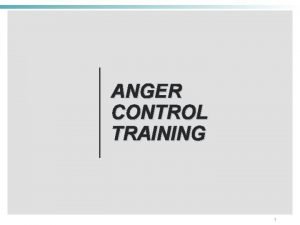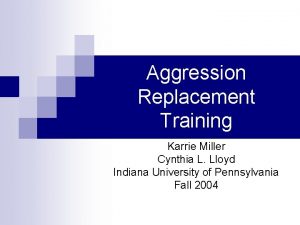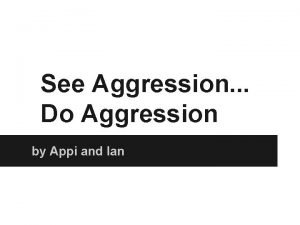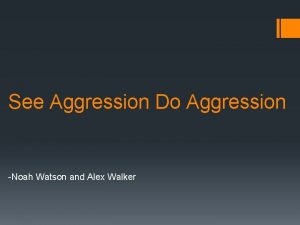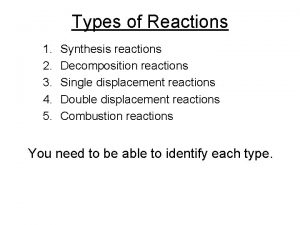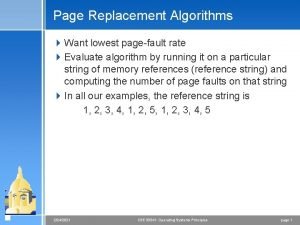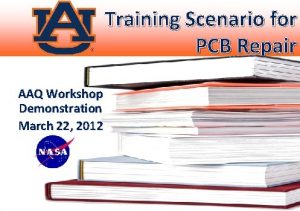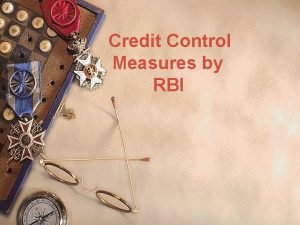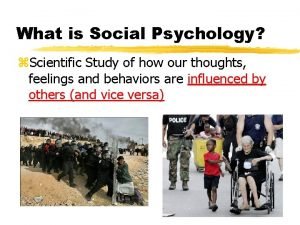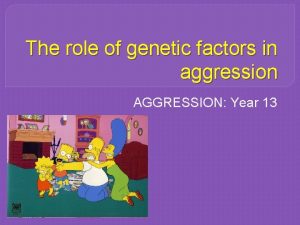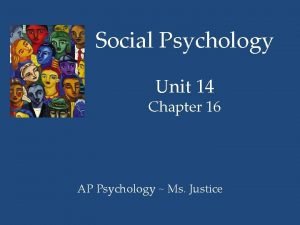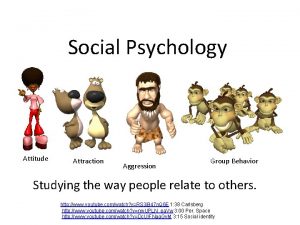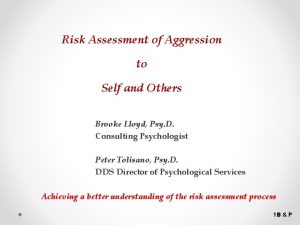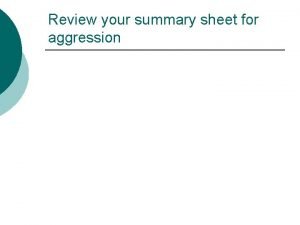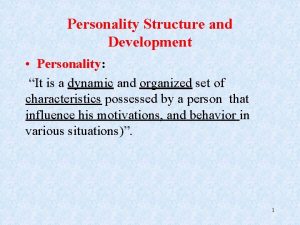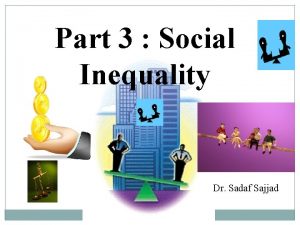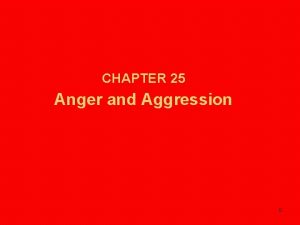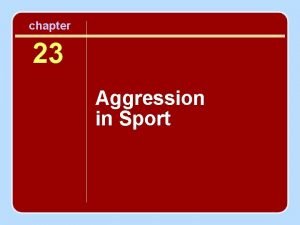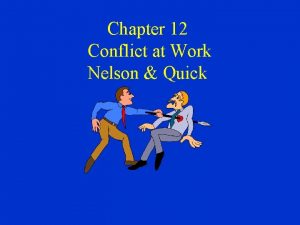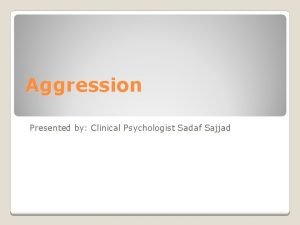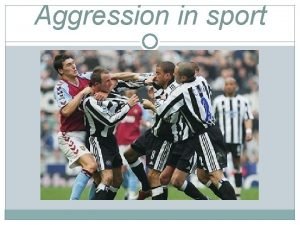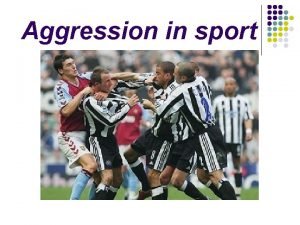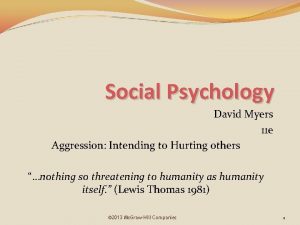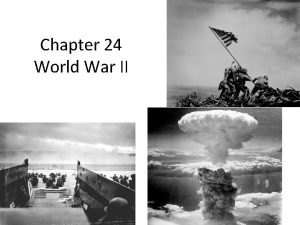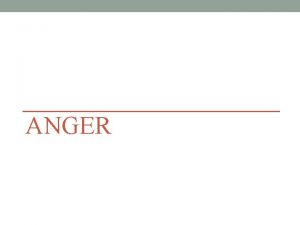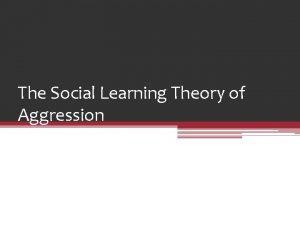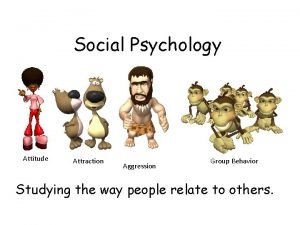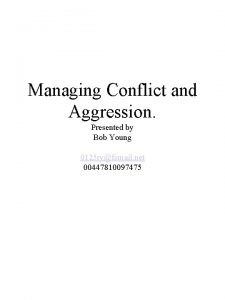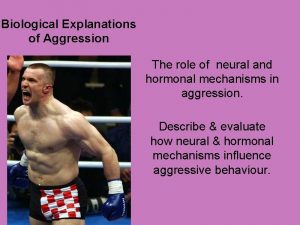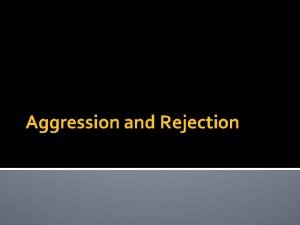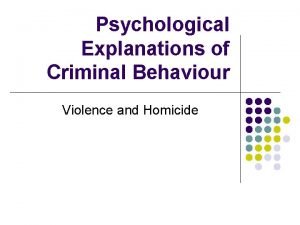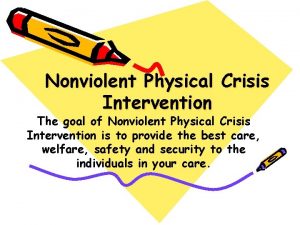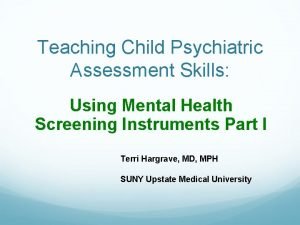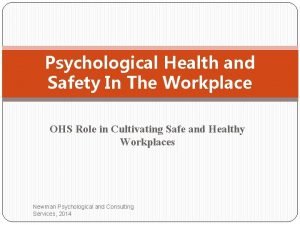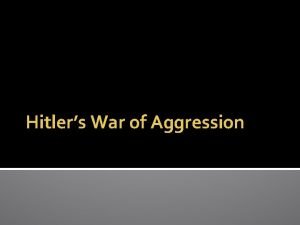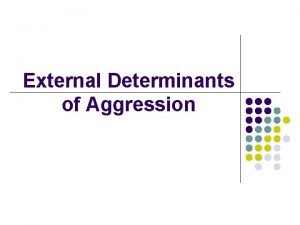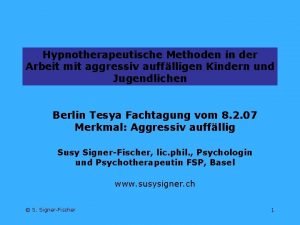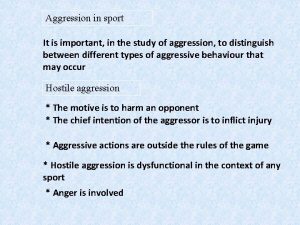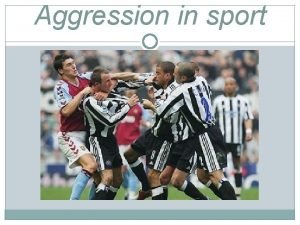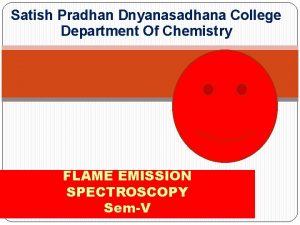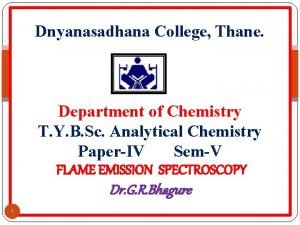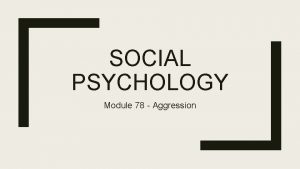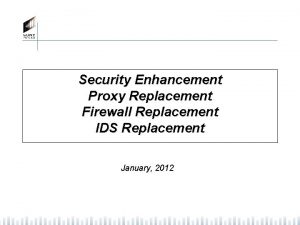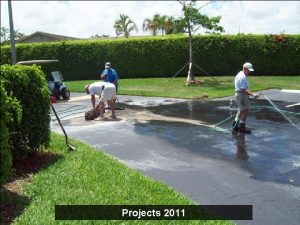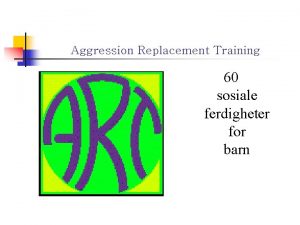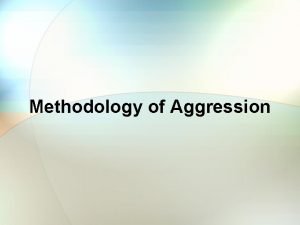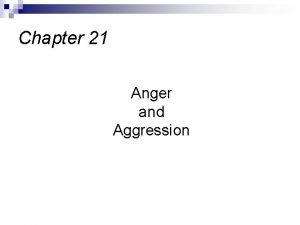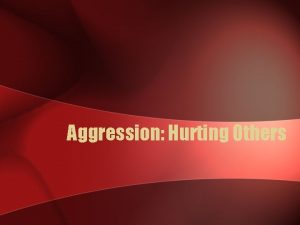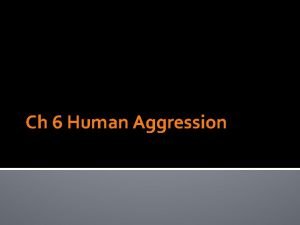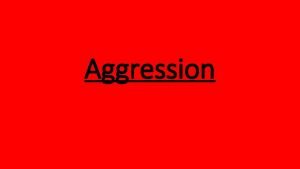Measures Used in CIMH Aggression Replacement Training Projects




























































- Slides: 60

Measures Used in CIMH Aggression Replacement Training™ Projects Cricket Mitchell, Ph. D CIMH Evaluation Consultant

Overview of Training: Measures Used in Aggression Replacement Training™ • Description, Administration, Scoring, and Clinical Utility – Program Outcome Measure: • Youth Outcome Questionnaires© (YOQ & YOQ-SR) – Component-Specific Outcome Measures: • Skill Streaming Checklists (for Skill Streaming) • Aggression Questionnaire© (for Anger Control) • How I Think Questionnaire© (for Moral Reasoning) – Satisfaction Questionnaires: • One for each of the three group components – Fidelity Forms: • One for each of the three group components 2

Aggression Replacement Training™ Program When Before Program (all group components) After Program (all group components) When Before componentspecific group cycle After each group/class After componentspecific group cycle What Youth Outcome Questionnaire-Self Report Skill Streaming What Who Skill Streaming Checklist youth Skill Streaming Checklist staff/teacher Fidelity Form for Skill Streaming Facilitator Skill Streaming Checklist youth Skill Streaming Checklist staff/teacher Skill Streaming Satisfaction Questionnaire Who youth Anger Control What Who Aggression Questionnaire Fidelity Form for Anger Control Aggression Questionnaire Anger Control Satisfaction Questionnaire youth Moral Reasoning What Who youth How I Think Questionnai re youth Facilitator Fidelity Form for Moral Reasoning Facilitat or youth How I Think Questionnai re youth Moral Reasoning Satisfaction Questionnai re youth 3

Note about “when” to administer: • The beginning and end of each componentspecific group cycle may also be the beginning and end of your Aggression Replacement Training™ program – Particularly when all three group components are run concurrently (as opposed to sequentially) • So, program outcome measures (i. e. , YOQSR) may be administered at the same time as component-specific outcome measures (i. e. , SS Checklist, AQ, HIT) 4

Aggression Replacement Training™ Program Outcome Measure: Youth Outcome Questionnaires© (YOQ & YOQ-SR) 5

YOQ & YOQ-SR Description • General measure of functioning • Assesses the global mental health functioning of children and youth – Parent/caregiver report for children ages 4 -18 – Self-report for adolescents 12 -18 • Sensitive to clinical change in short periods of time • Available at no fee under CIMH’s statewide license to partnering agencies • Required for all CSA-funded Cal. GRIP sites 6

YOQ & YOQ-SR Description • 64 items • 5 -point Likert scale response options* – – – • Six Scale Scores – – – Intrapersonal Distress (ID) Somatic (S) Interpersonal Relations (IR) Social Problems (SP) Behavioral Dysfunction (BD) Critical Items (CI) Never or Almost Never Rarely Sometimes Frequently • Total Score Almost Always or Always *response values vary by item 7

Example: Items from the YOQ-SR© • I want to be alone more than others my same age. • I argue or speak rudely to others. • I cooperate with rules and expectations of adults. • I have a hard time trusting friends, family members, or other adults. • My emotions are strong and change quickly. 8

YOQ & YOQ-SR Administration • Administered twice to assess program outcomes: 1. Pre-Aggression Replacement Training™ – Before running all three group components 2. Post-Aggression Replacement Training™ – After running all three group components 9

Aggression Replacement Training™ Program When Before Program (all group components) After Program (all group components) When Before componentspecific group cycle After each group/class After componentspecific group cycle What Youth Outcome Questionnaire-Self Report Skill Streaming What Who Skill Streaming Checklist youth Skill Streaming Checklist staff/teacher Fidelity Form for Skill Streaming Facilitator Skill Streaming Checklist youth Skill Streaming Checklist staff/teacher Skill Streaming Satisfaction Questionnaire Who youth Anger Control What Who Aggression Questionnaire Fidelity Form for Anger Control Aggression Questionnaire Anger Control Satisfaction Questionnaire youth Moral Reasoning What Who youth How I Think Questionnai re youth Facilitator Fidelity Form for Moral Reasoning Facilitat or youth How I Think Questionnai re youth Moral Reasoning Satisfaction Questionnai re youth 10

YOQ & YOQ-SR Administration • “… during the past 7 days. ” • Ask parents and youth to fill out the questionnaires as honestly as possible – Informants can easily be influenced by the attitude of the person administering the scale – Let them know that this questionnaire will help you, as a clinician, better understand how the child is doing overall • Ask parents and youth to complete all items 11

YOQ & YOQ-SR Scoring • For each item, transfer the value corresponding to the selected response into the box at the right-hand side of the page titled, ‘For Office Use Only’ – Each item loads onto one of the six scales (e. g. , ID, SP, IR) – Note that some items have negative response option values • Sum the items in each scale on Side 1 – Add the numbers in all boxes under the heading ID and enter that subtotal into the ID box at the bottom of the page – Repeat for each scale • • Sum the items in each scale on Side 2 Transfer the subtotals from Side 1 to Side 2 Sum the subtotals to determine Scale Scores Sum the Scale Scores to determine Total Score – Note that it is possible to have negative values for scores 12

NOTE!! Some statements have negative values!! 5 point scale Subscale boxes 0 2 3 0

YOQ & YOQ-SR Scoring • Missing Data (items that are left blank) – Substitute a mean item response for the missing item • Determine in which scale the missing item belongs • Add up the other items in that scale, and determine their average • Substitute the average score for the missing response (round up to the nearest whole number) – If 5 or more items are missing, consider the questionnaire invalid 14

Clinical Utility of the YOQ & YOQ-SR • Total Score – Possible scores range from -16 to 240 – Clinical cutpoints • 46 or higher on the YOQ • 47 or higher on the YOQ-SR – Lower scores indicate more normative, nonclinical, aspects of general mental health functioning • Elevations on certain scales indicate areas of specific distress for the child/youth 15

Clinical Utility of the YOQ & YOQ-SR • Intrapersonal Distress (ID) Scale – Possible scores range from -4 to 68 – Clinical cutpoints • 16 or higher on the YOQ • 17 or higher on the YOQ-SR – Assesses the amount of emotional distress in the child/youth, including anxiety, depression, fearfulness, hopelessness, and self-harm – High scores indicate a considerable degree of intrapersonal distress in the child/youth 16

Clinical Utility of the YOQ & YOQ-SR • Somatic (S) Scale – Possible scores range from 0 to 32 – Clinical cutpoints • 5 or higher on the YOQ • 6 or higher on the YOQ-SR – Indicates change in somatic distress or physical complaints – High scores indicate the parent/caregiver is aware of, or the youth is experiencing, a high number of somatic symptoms; while low scores indicate either absence or unawareness of them 17

Clinical Utility of the YOQ & YOQ-SR • Interpersonal Relations (IR) Scale – Possible scores range from -6 to 34 – Clinical cutpoints • 4 or higher on the YOQ • 3 or higher on the YOQ-SR – Assesses issues relevant to the child/youth’s relationship with parents, other adults, and peers – High scores indicate significant interpersonal difficulty; while low scores reflect a cooperative, pleasant interpersonal demeanor 18

Clinical Utility of the YOQ & YOQ-SR • Social Problems (SP) Scale – Possible scores range from -2 to 68 – Clinical cutpoints • 3 or higher on the YOQ & YOQ-SR – Assesses problems that are socially related including aggression and delinquency – A feature of these items is that they are slow to change; whereas, content tapped by many of the other scales often changes over a period of time as a result of treatment intervention 19

Clinical Utility of the YOQ & YOQ-SR • Behavioral Dysfunction (BD) Scale – Possible scores range from -4 to 40 – Clinical cutpoints • 12 or higher on the YOQ • 11 or higher on the YOQ-SR – Assesses inattention, hyperactivity, impulsivity, concentration, ability to organize tasks, and ability to handle frustration 20

Clinical Utility of the YOQ & YOQ-SR • Critical Items (CI) Scale – Possible scores range from 0 to 36 – Clinical cutpoints • 5 or higher on the YOQ • 6 or higher on the YOQ-SR – Assesses areas such as paranoia, obsessive -compulsive behaviors, hallucination, delusions, suicide, mania, and eating disorders 21

Clinical Utility of the YOQ & YOQ-SR • Assesses a variety of specific areas of difficulty in youth mental health functioning • Assists in initial clinical impressions • Provides valuable information to guide treatment/interventions • Comparisons of pre/post scores reveal areas of clinical improvement as well as areas of potential unmet need 22

Summary of YOQ/YOQ-SR Score Ranges and Clinical Cutpoints YOQ/YOQ-SR Scale Range of possible scores Clinical Cutpoint for YOQ-SR Intrapersonal Distress (ID) -4 to 68 16 17 Somatic (S) 0 to 32 5 6 Interpersonal Relations (IR) -6 to 34 4 3 Social Problems (SP) -2 to 30 3 3 Behavioral Dysfunction (BD) -4 to 40 12 11 0 to 36 5 6 -16 to 240 46 47 Critical Items (CI) Total Score 23

Aggression Replacement Training™ Component-Specific Outcome Measure for Skill Streaming: Skill Streaming Checklists 24

Skill Streaming Checklist Description • Measures the extent to which a youth exhibits prosocial skills (a strength-based measure) • Elementary and Adolescent versions available – Youth self-report – Parent/caregiver report – Teacher/staff report • Provided at no additional fee to all CIMH-sponsored Aggression Replacement Training™ sites • Required for all CSA-funded Cal. GRIP sites 25

Skill Streaming Checklist Description • 50 items (adolescent) • 60 items (elementary) • 5 -point Likert scale response options – – – Almost never (1) Seldom (2) Sometimes (3) Often (4) Almost always (5) • Total Score – Note: A subset of items can be administered, corresponding to the specific set of pro-social skills youth are being taught. This is referred to as a “targeted assessment”. 26

Example: Items from the Skill Streaming Checklist (adolescent) • Does the youngster pay attention to someone who is talking and make an effort to understand what is being said? – Skill: Listening • Does the youngster request assistance when he/she is having difficulty? – Skill: Asking for Help • Does the youngster let others know which emotions he/she is feeling? – Skill: Expressing Your Feelings 27

Skill Streaming Checklist Administration • “Targeted Assessment” – Pre- and Post- test only those skills that have been taught in your ART curriculum – i. e. , 10 skills are taught – those same 10 skills are selected for pre- and post- outcome assessment • When all 50 skills are assessed, the gains youth make in 10 skills tend to be washed out by the 40 skills that youth have not had an opportunity to learn and practice 28

Skill Streaming Checklist Administration • Administered twice to assess outcomes specifically related to participation in Skill Streaming groups: 1. Pre-Skill Streaming – Before running Skill Streaming groups 2. Post-Skill Streaming – After running Skill Streaming groups 29

Aggression Replacement Training™ Program When Before Program (all group components) After Program (all group components) When Before componentspecific group cycle (may also coincide with start of Program) After each group/class After componentspecific group cycle (may also coincide with end of Program) What Youth Outcome Questionnaire-Self Report Skill Streaming What Who Skill Streaming Checklist Aggression staff/teache Questionnaire r Facilitator Skill Streaming Checklist youth Skill Streaming Satisfaction Questionnaire Anger Control What Who youth Moral Reasoning What Who youth Fidelity Form for Skill Streaming Checklist Who Fidelity Form for Anger Control Aggression staff/teache Questionnaire r youth Anger Control Satisfaction Questionnaire youth How I Think Questionnai re youth Facilitator Fidelity Form for Moral Reasoning Facilitat or youth How I Think Questionnai re youth Moral Reasoning Satisfaction Questionnai re youth 30

Skill Streaming Checklist Scoring • Each item on the checklist has five response options with values ranging from 1 – 5 • To obtain the Total Score, sum the values of the responses circled by the respondent – If all 50 skills have been assessed, Total Scores will range from 50 – 250 – If 10 skills have been assessed, Total scores will range from 10 – 50 31

Clinical Utility of the Skill Streaming Checklist • Assesses youth’s use of pro-social skills – Higher scores indicate better use of pro-social skills – Lower scores indicate poorer use of pro-social skills • Informs which pro-social skills youth have the greatest need for intervention – Can be used to determine which subset of skills are selected for curriculum • Comparisons of pre/post scores demonstrate outcomes related to participation in Skill Streaming groups 32

Aggression Replacement Training™ Component-Specific Outcome Measure for Anger Control: Aggression Questionnaire© 33

Aggression Description © Questionnaire (AQ) • Measures youth tendencies to respond to situations in an aggressive manner – Youth self-report ages 9 -18 • Copyrighted and published by Western Psychological Services (WPS) • Strongly recommended for assessing the impact of participation in Anger Control groups 34

AQ© Description • 34 items • 5 -point Likert scale response options – – – • Five Scale Scores – – – Physical Aggression (PHY) Verbal Aggression (VER) Anger (ANG) Hostility (HOS) Indirect Aggression (IND) Not at all like me (1) A little like me (2) Somewhat like me (3) Very much like me (4) • Total Score Completely like me (5) 35

Example: Items from the AQ© • My friends say that I argue a lot. • I may hit someone if he or she provokes me. • I have threatened people I know. • I wonder what people want when they are nice to me. • I have become so mad I have broken things. 36

© Questionnaire Aggression Administration • Administered twice to assess outcomes specifically related to participation in Anger Control groups: 1. Pre-Anger Control – Before running Anger Control groups 2. Post-Anger Control – After running Anger Control groups 37

Aggression Replacement Training™ Program When Before Program (all group components) After Program (all group components) When Before componentspecific group cycle (may also coincide with start of Program) After each group/class After componentspecific group cycle (may also coincide with end of Program) What Youth Outcome Questionnaire-Self Report Skill Streaming What Who Skill Streaming Checklist Aggression Questionnair e staff/teacher Facilitator Skill Streaming Checklist youth Skill Streaming Satisfaction Questionnaire Anger Control What Who youth Moral Reasoning What Who youth Fidelity Form for Skill Streaming Checklist Who Fidelity Form for Anger Control Aggression Questionnair e staff/teacher youth Anger Control Satisfaction Questionnaire youth How I Think Questionnai re youth Facilitator Fidelity Form for Moral Reasoning Facilitat or youth How I Think Questionnai re youth Moral Reasoning Satisfaction Questionnai re youth 38

Aggression Questionnaire© Scoring • Tear off the perforated edge to open packet – The youth’s circled responses will show on the inside • For each item, transfer the value corresponding to the circled response into the box at the righthand side of the page titled – Each item loads onto one of the five scales (e. g. , PHY, VER, ANG) • Sum all responses in each scale to determine Scale Scores • Sum the Scale Scores to determine Total Score 39

Clinical Utility of the Aggression Questionnaire© • Assesses a variety of specific aspects of youth self-reported aggression – e. g. , physical, verbal, indirect • Informs which aspects of aggression youth have the greatest need for intervention • Comparisons of pre/post scores demonstrate outcomes related to participation in Anger Control groups 40

Aggression Replacement Training™ Component-Specific Outcome Measure for Moral Reasoning: How I Think Questionnaire© 41

© Questionnaire How I Think (HIT) Description • Measures youth tendencies to engage in selfserving cognitive distortions, or thinking errors – Youth self-report for ages 12 -19 • Copyrighted and published by Research Press • Strongly recommended for assessing the impact of participation in Moral Reasoning groups 42

HIT© Description • 54 items • 6 -point Likert scale response options – – – Disagree strongly (1) Disagree (2) Disagree slightly (3) Agree slightly (4) Agree (5) Agree strongly (6) • Eight Scale Scores – – – – Self-Centered (SC) Blaming Others (BO) Minimizing/Mislabeling (MM) Assuming the Worst (AW) Opposition-Defiance (OD) Physical Aggression (PA) Lying (L) Stealing (S) • Total Score 43

Example: Items from the HIT© • People should try to work on their problems. • If I see something I like, I take it. • When I get mad, I don’t care who gets hurt. • Everybody lies, it’s no big deal. • You should get what you need, even if it means someone has to get hurt. 44

© Questionnaire How I Think Administration • Administered twice to assess outcomes specifically related to participation in Moral Reasoning groups: 1. Pre-Moral Reasoning – Before running Moral Reasoning groups 2. Post-Moral Reasoning – After running Moral Reasoning groups 45

Aggression Replacement Training™ Program When Before Program (all group components) After Program (all group components) When Before componentspecific group cycle (may also coincide with start of Program) After each group/class After componentspecific group cycle (may also coincide with end of Program) What Youth Outcome Questionnaire-Self Report Skill Streaming What Who Skill Streaming Checklist Anger Control What Who youth Moral Reasoning What Who youth staff/teacher Fidelity Form for Skill Streaming Facilitator Skill Streaming Checklist youth Skill Streaming Checklist staff/teacher Skill Streaming Satisfaction Questionnaire Who youth Aggression Questionnaire youth How I Think Questionnai re youth Fidelity Form Facilitat for Anger for Moral Facilitator or Control Reasoning Aggression Questionnaire Anger Control Satisfaction Questionnaire youth How I Think Questionnai re youth Moral Reasoning Satisfaction Questionnair e youth 46

How I Think Questionnaire© Scoring • Use the HIT Questionnaire Computational Form – Only one is provided with each HIT manual, this form will need to be copied to score each HIT • For each item, transfer the value corresponding to the circled response into box under the appropriate scale (item # in parentheses) – Each item loads onto one of the nine scales • Determine each scale’s Mean score – Sum all responses and divide by the number of items in that scale • Determine the Mean Summary Scores (e. g. Overt Scale, Covert Scale, Overall HIT Score) 47

Clinical Utility of the How I Think Questionnaire© • Assesses a variety of specific aspects of selfserving youth thinking errors that are likely to contribute to aggression and delinquent behavior – e. g. , blaming others, assuming the worst, minimizing and mislabeling • Informs which aspects of thinking errors and associated delinquent behavior youth have the greatest need for intervention • Comparisons of pre/post scores demonstrate outcomes related to participation in Moral Reasoning groups 48

Aggression Replacement Training™ Satisfaction Measures 49

Satisfaction Questionnaires • Youth self-report satisfaction questionnaires – Project-developed – Component-specific (one for each of the three types of ART® groups) – Six questions each • 5 -point Likert Scale (Strongly Disagree, Neither Agree nor Disagree, Agree, Strongly Agree) • Available through CIMH 50

Example: Skillstreaming Youth Satisfaction Questionnaire • • • I enjoyed being in the Skill Streaming groups. I learned new skills in these groups. I think the group leaders were helpful. The other kids/teens in my group were helpful. I would be in a group like this again, if I had the chance. • I would tell a friend to be in a group like this, if he or she had the chance. 51

Satisfaction Questionnaires Administration • Administered once to assess youth satisfaction with participation in each of the three group components of Aggression Replacement Training™: 1. Post-group participation – After running each group cycle 52

Aggression Replacement Training™ Program When Before Program (all group components) After Program (all group components) When Before componentspecific group cycle After each group/class After componentspecific group cycle (may also coincide with end of Program) What Youth Outcome Questionnaire-Self Report Skill Streaming What Who Skill Streaming Checklist youth Skill Streaming Checklist staff/teacher Fidelity Form for Skill Streaming Facilitator Skill Streaming Checklist youth Skill Streaming Checklist staff/teacher Skill Streaming Satisfaction Questionnaire Who youth Anger Control What Who Aggression Questionnaire youth Moral Reasoning What Who How I Think Questionnair e youth Fidelity Form Facilitat for Anger for Moral Facilitator or Control Reasoning Aggression Questionnaire Anger Control Satisfaction Questionnair e youth How I Think Questionnair e youth Moral Reasoning Satisfaction Questionnai re youth 53

Aggression Replacement Training™ Fidelity Forms 54

Fidelity Forms • Facilitator-completed measure of the activities conducted within each group – Developed by the ETA Master Trainers – Component-specific (one for each of the three types of ART® groups) – 5 -point Likert Scale (Never, Seldom, Sometimes, Always, Often) • Completed fidelity forms are faxed to Master Trainer prior to consultation calls – Serve as the basis for consultation and for developing the model-adherence of each facilitator within each group component • Required for all Aggression Replacement Training™ programs 55

Example: Skillstreaming Fidelity Form • Were any issues from last Skill Streaming group reviewed? • Was the skill introduced, steps read and briefly explained? • Was skill modeled by Trainer/Co-trainer? • Were all the steps for performing the skill identified during modeling? • Did each youth role-play the skill of the session as the Main Actor? 56

Fidelity Form Completion • Completed by facilitator (and co-facilitator) after every group – In any given week, there will likely be many fidelity forms completed • Completed fidelity forms are faxed (or emailed) to Master Trainer prior to consultation calls 57

Aggression Replacement Training™ Program When Before Program (all group components) After Program (all group components) When Before componentspecific group cycle After each group/class After componentspecific group cycle What Youth Outcome Questionnaire-Self Report Skill Streaming What Who Skill Streaming Checklist youth Skill Streaming Checklist staff/teacher Fidelity Form for Skill Streaming Facilitator Skill Streaming Checklist youth Skill Streaming Checklist staff/teacher Skill Streaming Satisfaction Questionnaire Who youth Anger Control What Who Aggression Questionnaire youth Moral Reasoning What Who How I Think Questionnai re youth Fidelity Form for Anger Facilitator Control Fidelity Form for Facilitat or Moral Reasoning Aggression Questionnaire youth How I Think Questionnai re youth Moral Reasoning Satisfaction Questionnai re youth Anger Control Satisfaction Questionnaire 58

Questions 59

The End Contact Information • Cricket Mitchell, Ph. D • Email: cmitchell@cimh. org • Cell phone: 858 -220 -6355 60
 Aggression replacement training facilitator training
Aggression replacement training facilitator training Anger reducers
Anger reducers Karrie miller
Karrie miller Aggression replacement training anger control chain
Aggression replacement training anger control chain See aggression do aggression
See aggression do aggression See aggression do aggression
See aggression do aggression Combustion reaction formula
Combustion reaction formula Repeated measures design
Repeated measures design Least recently used algorithm calculator
Least recently used algorithm calculator Pcb repair training
Pcb repair training Credit control measures of rbi
Credit control measures of rbi Weights and measures training
Weights and measures training Self fulfilling prophecy meaning
Self fulfilling prophecy meaning Outline the role of genetic factors in aggression
Outline the role of genetic factors in aggression Examples of verbal aggression
Examples of verbal aggression What is frustration in psychology
What is frustration in psychology Groupthink vs group polarization
Groupthink vs group polarization Aggression types psychology
Aggression types psychology Group behavior psychology
Group behavior psychology Aggression risk assessment
Aggression risk assessment Theory of aggression
Theory of aggression Laughter as a defense mechanism
Laughter as a defense mechanism Sadaf sajjad
Sadaf sajjad Chapter 27 anger aggression and violence
Chapter 27 anger aggression and violence Assault cycle stages
Assault cycle stages Instinct theory in sport
Instinct theory in sport Incompatible goals
Incompatible goals Example of direct aggression
Example of direct aggression Instrumental aggression definition
Instrumental aggression definition Aggression im sport definition
Aggression im sport definition Theory of aggression
Theory of aggression Social determinants of aggression
Social determinants of aggression International response to german aggression
International response to german aggression Three reasons to use supportive stance
Three reasons to use supportive stance Aggression in the pacific map
Aggression in the pacific map Anger vs aggression
Anger vs aggression Social learning theory of aggression
Social learning theory of aggression Lapiere 1934 study
Lapiere 1934 study Big bob aggression
Big bob aggression Biological explanations of aggression
Biological explanations of aggression Effects of aggression
Effects of aggression Expressive aggression
Expressive aggression Cpi supportive stance picture
Cpi supportive stance picture Modified overt aggression scale score interpretation
Modified overt aggression scale score interpretation Aggression nature vs nurture
Aggression nature vs nurture Fear factory aggression continuum
Fear factory aggression continuum Nazi aggression map
Nazi aggression map Importation model definition
Importation model definition Nazi aggression map
Nazi aggression map Llll heat
Llll heat Aggression cycle
Aggression cycle Hypnose aggression
Hypnose aggression Deindividuation theory
Deindividuation theory Frustration aggression theory in sport
Frustration aggression theory in sport Define aggression in sport
Define aggression in sport Rugby aggression
Rugby aggression In a premix burner used in fes the fuel used is
In a premix burner used in fes the fuel used is In a premix burner used in fes the fuel used is
In a premix burner used in fes the fuel used is Training is expensive without training it is more expensive
Training is expensive without training it is more expensive Metode of the job training
Metode of the job training Optical illusions science fair projects
Optical illusions science fair projects

